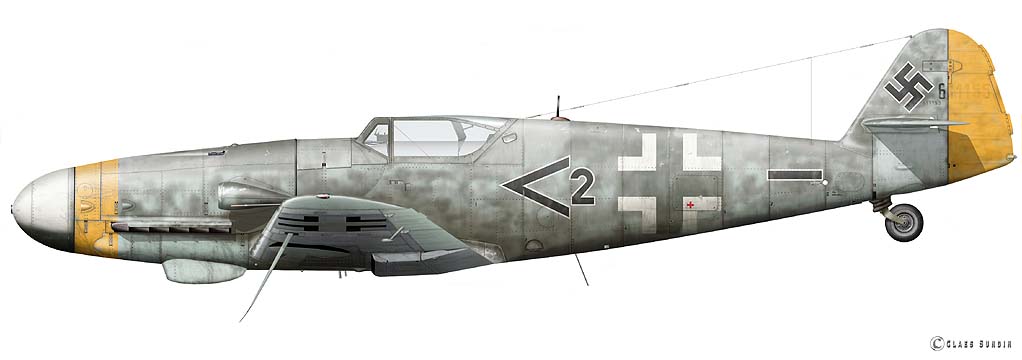



|
A question I often get as an aircraft illustrator is: "why don't you do both a right and left profile of the planes you portray". Given that I always have documentation in form of at least one photo of all the profiles I make, the answer is rather strait forward, to keep the speculations down to the minimum making a historical correct profile this is impossible to make because an particular aircraft have very rarely been documented from both the right and left had side. This would also be my answer to enthusiasts who want me to make profiles of both the underside and top views. photos that are even more scarce. So my answer to those who buy my books who is missing one of the profile side, is that your guess is as good as mine and not to be fooled by painting and decal instructions from all the plastic model manufacturers out there, as they should know that at least one of the sides portrayed (at best) is pure speculation. At least that is my experience after making more than 2 000 Luftwaffe planes. In fact I can only remember to have stumble over a handful where both fuselage sides has been documented, including Adolf Galland's Bf 109 Emil, the Fw 190 D-11 "Rote 2" and this profile of a Bf 109 G-10 from Stab/JG 52. Two of latter is made during the last few weeks and all have been or should be published in my profile books. Note that on the D-11 and the G-10, besides the camouflage the markings on the fuselage are not identical, and apparently stencils have not been used, instead both the chevrons and numerals must have been applied by hand by the "Black men". Note also that the G-10 have been refined, as the ariel attachment on top of the rudder is change, a proof of that new photos results in refinements to my older profiles. In late April 1945, the Western and Eastern Allies were closing in on Austria, with the 11th US Armored Division from the north and the Soviet 2nd and 3rd Ukrainian Front from the east. The hard-pressed German defenders were now staring down the barrel. At this time, II./JG 52 was based at Wien-Aspen in Austria directly in the path of the advancing Soviets. Under the command of Hptm. Wilhelm Batz, they flew fighter sweeps and escort missions for ground attack Stukas and Hs 129s. The enemy often appeared in large numbers of up to 30 machines, resulting in few claims and higher losses. Most of the losses however were due to the concrete landing-strip at the base, resulting in 13 damaged machines, including Batz's own "Doppelwinkel" K-4. One of the planes even caught fire, the Bf 109 flown by Gerfrieter Writsch, and the fire brigade soon arrived. One of the "firemen" that participated in putting out the fire later became the wife of the ace Peter Düttmann, the Staffelkapitän of the 5. Staffel. As the Soviets approached Wien (Vienna) the Gruppe was forced to move to Seyring and a few days later to Fels am Wagram. II./JG 52 was based here for over a week flying an increasing number of missions, mostly fighter sweeps and escorts for SG 2 and SG10 Fw 190s but also conducting its own strafing sorties. After a move to Brünn, the unit was soon back in Fels am Wagram. Then they were called to the north where US forces were advancing, so on 17 April they were based at Hörsching, 12 km southwest of Linz. Here the pilots conducted the same type of missions as before, although in some instances their Bf 109s were loaded up with four 50 kg bombs to attack tanks and trucks. And during these actions the last claim of the Gruppe was filed on 24 April, when Lt. Düttmann destroyed a Sherman tank 5 km southwest of Chan. This victory was to be filed as Düttmans 151st Abschusse, part of the 3,530 total Abschüsse for II./JG 52. Thereafter the Gruppe was relocated another three times before finally ending up in Zeltweg. Here on 7 May 1945, the personnel of JG 52 learned of the unconditional surrender of the Wehrmacht. I n an effort not to fall into the hands of the Soviets the order was given to fly all aircraft over to US-held territory and that the rest of the unit should travel by road in an effort to surrender to the "right" enemy. As a final act, the remnants of the Gruppe landed at Neubiberg air base, close to München, including the machine flown by Uffz, Anton Kellmaier. Little is known of Kellmeier other than he claimed three victories in 1945. The first one was claimed on 6 January, an Il-2H shot down over Babolnapussta at 15:00 hours. The next 'kill' was filed on 19 March, a La-5 shot down during a morning sortie, at 07:30 over Vesprem. The third and final claim was also a La-5, shot down the next day, the enemy fighter crashing at Stuhlweissenburg at 15:03 hours. This is one of the 130 profiles subjects found in my Profile book No 10, now updated with an right-hand side profile, a rofile probebly included in profile book No 15. |
|
|
|
|
|
|